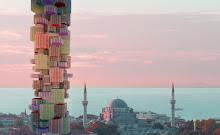What I find so fascinating about places like Croatia is how they evolve as crossroads for multiple civilizations. During the centuries of development, different cultural influences, styles of architecture, flavors and textures have layered on top of each other like an intricate and complex collage. When you visit the various cities, towns and islands, fragments of each civilization become visible and make a very unique whole. But then of course, everything becomes all the more visually stimulating when you have the pristine blue backdrop of the Adriatic.
The first morning I walked through the thick walls of the fortress and entered the old town, it felt like I had stumbled right onto Hollywood sound stage. It seemed just so perfect. The more I walked around, I just simply could not imagine that this idyllic town was under siege for two years from 1991 to 1992 by Serb forces. According to an exhibition I saw in Dubrovnik, it is still unclear as to why Serbian forces shelled Dubrovnik at all - given that it was not a strategic location for the war and it clearly became a misjudgement in military strategy. One possible explanation is given its jewel-like reputation, it was attacked as many highly valued cultural sites often are in war, to demoralize its people. In spite of that, the majority of Croats survived in large part to hiding within the thick, encompassing city walls - which you can now climb for a small fee.
By 2006, with the help of UNESCO, the old town was rebuilt with only a few bullet holes in buildings and a war exhibition to remind any visitor or local of a history that should not be repeated.
 The various shades of the orange tiles differentiate between the original roofs and those that were rebuilt after the war.
The various shades of the orange tiles differentiate between the original roofs and those that were rebuilt after the war. On the other side of the city walls is the Adriatic Sea with the occasional sailboat, yacht or ocean liner (unfortunately). There were two the second time we were there.
On the other side of the city walls is the Adriatic Sea with the occasional sailboat, yacht or ocean liner (unfortunately). There were two the second time we were there.

 14th Century Franciscan Monastery which houses the oldest working pharmacy in Europe apparently (from 1317)
14th Century Franciscan Monastery which houses the oldest working pharmacy in Europe apparently (from 1317)
The only downside to our visit to Split (besides our throwback-to-communist-era-hotel; their service was as engaging) was that during the time we were there, two US navy ships were docked off the coast of Split. They were monitoring the elections in neighboring Montenegro. The day we were in Split, the city was overrun with thousands of US marines. Not quite the cultural experience I was hoping for in Croatia.
Of course with the amount of publicity Croatia has received over the past few years in travel magazines, Hvar is no longer a quiet local summer retreat. Gaining the reputation as the Adriatic Riviera, Hvar is now often frequented by yachts of the rich and famous. While we were there, rumors were a buzz of hotel chains and luxury resorts that were in the pipeline. Pity.


 The vegetation on this island was puzzling - cacti and aloe hiding under shade of a pine tree. (See a foot anywhere?)
The vegetation on this island was puzzling - cacti and aloe hiding under shade of a pine tree. (See a foot anywhere?) A sign for a business in Hvar. I liked the use of rust to mark the name of the company. Rather creative, I thought.
A sign for a business in Hvar. I liked the use of rust to mark the name of the company. Rather creative, I thought.





























No comments:
Post a Comment